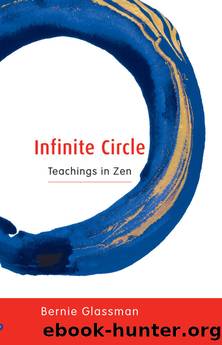Infinite Circle by Bernie Glassman

Author:Bernie Glassman
Language: eng
Format: epub
Publisher: Shambhala Publications
7
Letting Go of Letting Go
Gate, gate, paragate, parasamgate, bodhi svaha!
Gone, gone, have gone, altogether have gone!
As I wrote in Chapter 1, the Perfection of Great Wisdom Sutra exists in many different lengths, starting from one hundred thousand lines to the present version of twenty-four lines. Each version is a narrower condensation of the version before it. Some say the one-line mantra that concludes this version—“Gate, gate, paragate, parasamgate, bodhi svaha!”—is the next condensation. Finally, there is the single vowel, A, the first syllable of the sutra. And even A is unnecessary, for this very moment is the Wisdom literature; this very moment is the perfection of wisdom.
What is perfection of wisdom? Let’s look at some important elements that are the core of our practice as well as our lives. In face-to-face study, a student expresses agony over a relationship that ended two years ago and asks me how to let go. What is letting go? There is a little toy called a Chinese finger-trap: You put two fingers into it, then try to pull them out. But you can’t extricate your fingers from the trap by pulling; it’s only when you push your fingers further in that the trap releases them. Similarly, we think of letting go as doing something: throwing things away, ending a relationship, getting rid of whatever’s bothering us. But that works no better than pulling our fingers in order to extricate them from the trap. We let go by eliminating the separation between us and what we wish to let go of. We become it.
Do we let go of anger by saying good-bye or going away? Of course not! That doesn’t work. The way to let go of anger is to enter the anger, become the anger rather than separate from it. If you even hold on to the notion of having to let go of it, you’re still stuck. In a famous koan, a monk went to Chao-chou Ts’ung-shen and asked, “What shall I do now that I’ve let go of everything?” Chao-chou said, “Let go of that!” The monk said, “What do you mean, let go of that? I’ve let go of everything.” Chao-chou answered, “Okay, then continue carrying it with you.” The monk failed to get the point. Holding on to letting go is not letting go.
We don’t get rid of anger by trying to get rid of it; the same applies to forgetting the self. To forget the self means to become what is, become what we are. How do we let go of a painful relationship? Become the person we wish to let go of, become the pain itself. We think we’re not the person, not the pain, but we are. Eliminate the gap between subject and object and there’s no anger, no loss of relationship, no sorrow, no suffering, no observer sitting back and crying, “Poor me!”
The Chinese finger-trap is solved by going further into the trap, by becoming the trap, and the same is true of letting go: Go into it.
Download
This site does not store any files on its server. We only index and link to content provided by other sites. Please contact the content providers to delete copyright contents if any and email us, we'll remove relevant links or contents immediately.
Four Thousand Weeks by Oliver Burkeman(1800)
What Happened to You? by Oprah Winfrey(1747)
Karma by Sadhguru(1587)
This Changes Everything by Unknown(1490)
You Are a Badass: How to Stop Doubting Your Greatness and Start Living an Awesome Life by Jen Sincero(1151)
Don't Sweat the Small Stuff...and It's All Small Stuff by Richard Carlson(1095)
Infinite Circle by Bernie Glassman(1035)
How to Do the Work by Dr. Nicole LePera(981)
Let's Talk About Hard Things by Anna Sale(966)
Declutter Your Mind: A step by step guide to learn to control your thoughts, stop worrying, relieve anxiety and eliminate panic attacks and negative thinking by Mia Chandler(939)
Real Strength: Build Your Resilience and Bounce Back From Anything by Psychologies Magazine(930)
The 4-Hour Workweek by Timothy Ferris(929)
Who Moved My Cheese? by Spencer Johnson(926)
The Path of Greatness--The Game of Life and How to Play It and Other Essential Works by Florence Scovel Shinn(908)
Breakup Bootcamp by Amy Chan(880)
Be Your Best Self by Mike Bayer(875)
Curative Magic by Rachel Patterson(864)
Advice for Working Moms (HBR Working Parents Series) by unknow(844)
The Book of Hope by Jane Goodall(844)
